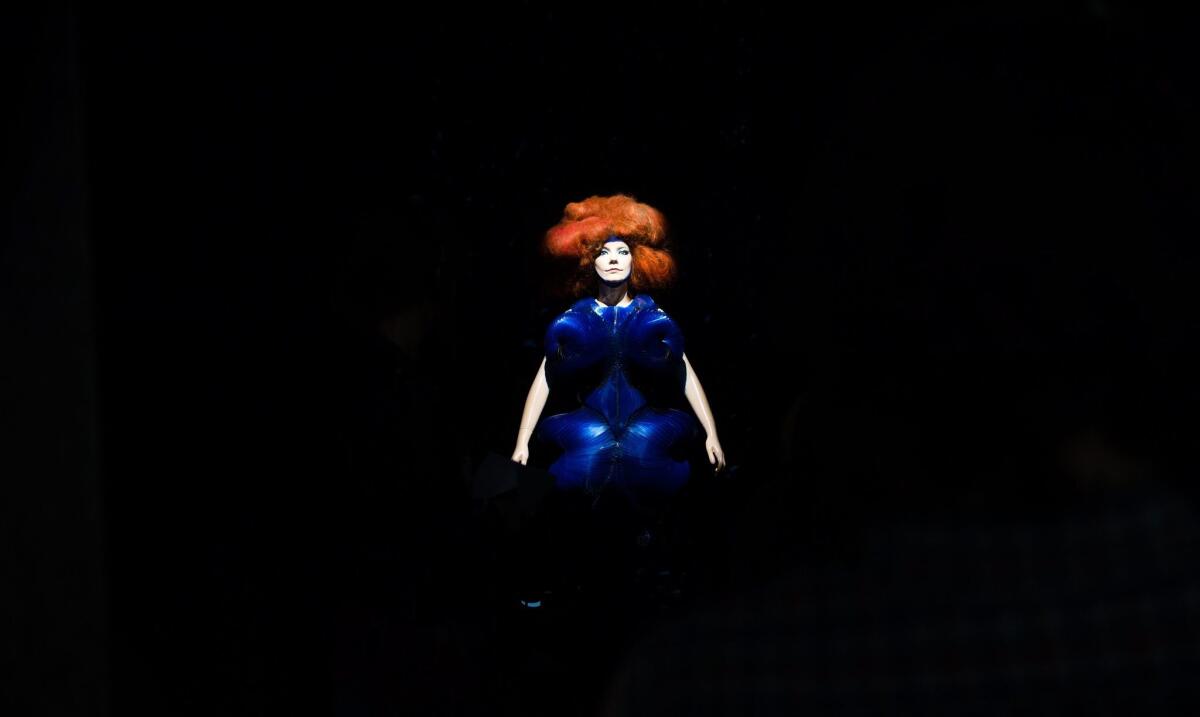Björked: Jerry Saltz burns his MoMA press pass and more artsy discontent

There are pile-ons. And then there are pile-ons involving Spandex, face-paint and atomic knee drops.
The retrospective devoted to the career of the singer, composer and musician Björk at the Museum of Modern Art has generated a full-on media smack down involving burning and pillaging. OK, so there hasn’t been any pillaging — but this week one major art critic who hated the show burned his MoMA press pass and posted the image of his card in flames on Twitter.
It all started with the reviews — which, to put it mildly, have not been kind. New York Times chief critic Roberta Smith describes the show as a “scant, cramped overview” ... “jammed into a tacky little two-story pavilion.” She concludes: “Björk should have said no — not because her work isn’t museum-worthy but because, as proved here, the Modern is not up to the task.”
Jason Farago of the Guardian describes “a weirdly unambitious show, with definitely, definitely, definitely no logic,” while Peter Schjeldahl of the New Yorker says that “MoMA comes off ridiculous in the way of a wannabe groupie.”
All of this was predicted by critic Ben Davis of Artnet, who in early March wrote, “You may expect an immense Eyjafjallajökull-sized ash-plume of critical bile to appear over midtown any second now. Because, ladies and gentlemen, this show is bad.”
That was an understatement. Because now the critics are taking it up a notch.
On Tuesday, Christian Viveros-Fauné, who contributes to publications such as the Village Voice and ArtReview, wrote a stinging analysis of MoMA’s power structure and curatorial approach for Artnet. The headline of the piece called for the show’s curator Klaus Biesenbach to be fired.
“Biesenbach — the institution’s Übersocial, fame-obsessed, Chief Curator at Large — has seemingly finally come in for some in-house scrutiny,” he writes. “A growing consensus outside the institution says it’s about time.”
That same day, New York Magazine critic Jerry Saltz, whose review titled “MoMa’s Bjork Disaster,” describes the show as a “self-inflicted wound,” basically flamed MoMA with that Twitter image of his burning MoMA press pass.
It was like a double chokeslam.
Except it wasn’t over. Critic Howard Halle of Time Out New York came in with a Stone Cold Stunner on Wednesday, in the form of a Facebook status update in which he wrote that the real culprit in all of this is MoMA’s board.
“It’s a bit rich that unnamed board members are now shocked, SHOCKED! that MoMA has been catering to tourists,” he writes. “I certainly agree that the Björk show stinks up the joint, but in theory it could have worked had the star not stayed in her dressing room instead of going onstage.”
He also states that critics shouldn’t be taking down pop culture in their efforts to take down the show. “If popular culture is such a linchpin for artists, why shouldn’t the real deal be represented in museums?” he asks. “The point is to do it right, as opposed to not doing it all.”
Halle’s statement has been helpfully republished by Hyperallergic (which gets a gold star for its MoMA/Björk/Biesenbach mash-up graphic).
The museum and Biesenbach are remaining circumspect on the matter on the critical outcry. (Though Biesenbach has continued his assiduous posting to Instagram.)
In the meantime, to any museum that wants to do shows tied to popular culture and be taken seriously, may I suggest you pay a visit to Kahlil Joseph’s video installation at the Museum of Contemporary Art in Los Angeles (an institution that has had its own issues in the past with staging exhibitions that are too much pop and not enough culture). Joseph’s installation shows that ideas that emerge from the popular culture can be smart and relevant, not to mention downright hypnotic.
That may be something the left coast knows a thing or two about.
Find me on the Twitters @cmonstah.
More to Read
The biggest entertainment stories
Get our big stories about Hollywood, film, television, music, arts, culture and more right in your inbox as soon as they publish.
You may occasionally receive promotional content from the Los Angeles Times.











